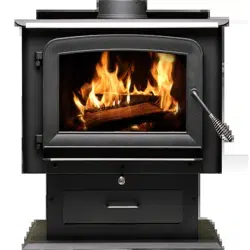Loading ...
Loading ...
Loading ...

negative pressure in the house. If such is the case, open a window slightly near the stove and twist together a few
sheets of newspaper into a torch. Light up this paper torch and hold it as close as possible to the mouth of the
pipe inside the combustion chamber to warm up the chimney. Once the updraft movement is initiated, you are
ready to ignite the stove by lighting the paper and kindling wood inside the combustion chamber.
HEATING
Controlled combustion is the most efcient technique for wood heating because it enables you to select the type
of combustion you want for each given situation. The wood will burn slowly if the woodstove air intake control is
adjusted to reduce the oxygen supply in the combustion chamber to a minimum. On the other hand, wood will
burn quickly if the air control is adjusted to admit a larger quantity of oxygen in the combustion chamber. The air
intake control on your stove is very simple. If you pull on it out completely towards you, it is fully open. If you push
on it until it stops the combustion air is reduced to a minimum. Real operating conditions may give very different
results than those obtained during testing according to the species of wood used, its moisture content, the size
and density of the pieces, the length of the chimney, altitude and outside temperature.
EFFICIENCY
Efciencies can be based on either the lower heating value (LHV) or the higher heating value (HHV) of the fuel.
The lower heating value is when the water leaves the combustion process as a vapor, in the case of woodstoves
the moisture in the wood being burned leaves the stove as a vapor. The higher heating value is when the water
leaves the combustion process completely condensed. In the case of woodstoves, this would assume the
exhaust gases are room temperature when leaving the system, and therefore calculations using this heating
value consider the heat going up the chimney as lost energy. Therefore, efciency calculated using the lower
heating value of wood will be higher than the efciency calculated using the higher heating value. In the United
States, all woodstove efciencies should be calculated using the higher heating value.
The best way to achieve optimum efciencies is to learn the burning characteristic of this appliance and burn
well-seasoned wood. Higher burn rates are not always the best heating burn rates; after a good re is established
a lower burn rate may be a better option for efcient heating. A lower burn rate slows the ow of usable heat out
of the home through the chimney, and it also consumes less wood.
VISIBLE SMOKE
The amount of visible smoke being produced can be an effective method of determining how efciently the
combustion process is taking place in the given settings. Visible smoke consists of unburned fuel and moisture
leaving your stove. Learn to adjust the air settings of your specic unit to produce the smallest amount of visible
smoke. Wood that has not been seasoned properly and has a high wood moisture content will produce excess
visible smoke and burn poorly.
Burn Rate Adjust Damper from fully closed Burn Time Blower Speed
Low Fully Closed @ 30 minutes Low
Medium - Low Approx. 11/16” open @ 30 minutes Low
Medium - High Approx. 1-7/16” open @ 30 minutes Low
High Fully Open approx. 2-18” from closed all minutes High
WARNINGS:
• NEVER OVERFIRE YOUR STOVE. IF ANY PART OF THE STOVE STARTS TO GLOW RED, OVER FIRING IS HAPPENING.
READJUST THE AIR INTAKE CONTROL AT A LOWER SETTING.
• THE INSTALLATION OF A LOG CRADLE OR GRATES IS NOT RECOMMENDED IN YOUR WOOD STOVE. BUILD FIRE
DIRECTLY ON FIREBRICK.
• NEVER PUT WOOD ABOVE THE FIREBRICK LINING OF THE FIREBOX.
• ATTEMPTS TO ACHIEVE HEAT OUTPUT RATES THAT EXCEED HEATER DESIGN SPECIFICATIONS CAN RESULT IN
PERMANENT DAMAGE TO THE HEATER.
Loading ...
Loading ...
Loading ...
